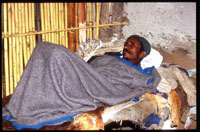7.1.1 The symptoms and signs of malaria
The clinical symptoms of malaria vary from very mild to very severe, depending on several factors. In areas where malaria is very common, adults with the disease may show just a slight increase in body temperature. However, pregnant women, and in particular, young children, often have a severe illness with many symptoms. The most important symptom of malaria is fever (or a history of fever within the last two to three days). An attack often begins with shivering (body shaking). This is followed by a period of fever, and finally there is profuse sweating. During an attack the patient often complains of headache and pains in the back, joints, and all over the body (Figure 7.1).

There may also be loss of appetite, vomiting, and diarrhoea. The patient may feel better the next day, but may have another attack the day after that, and so on. If untreated (or inadequately treated), malaria can cause several weeks or months of poor health because of repeated attacks of fever, anaemia (see Box 7.1) and general weakness. Some patients rapidly become very ill and may die within a few days.
Box 7.1 Anaemia
Anaemia means not enough haemoglobin in the blood. Haemoglobin is the red substance in the red blood cells which carries oxygen. Malaria parasites destroy the red blood cells and so malaria may cause anaemia. Anaemia may also have other causes (for example, not enough iron in the food). You can recognise anaemia by looking at the patient’s hands: the palms of a person with anaemia do not have the redness of a healthy person’s palms. If the red colour of the inner eyelid or mouth is paler than in a healthy person, the patient has anaemia. Breathlessness and a fast pulse may also be present, because the person’s blood cannot carry enough oxygen for their needs.
A critical feature that may help you to recognise if a fever is due to malaria or not is that malarial fever occurs in cycles – periods of fever alternate with periods in which the patient shows normal body temperature (below 37.5°C) and no symptoms. The stages of malarial fever attacks are shown in Table 7.1. (You will learn more about how to identify malaria cases in Section 7.2.3).
| Stage of malarial fever attack | |||
|---|---|---|---|
| Stage name | Cold stage | Hot stage | Sweating stage |
Main clinical symptoms |
|
|
|
| How long symptoms last | 15–60 minutes | 2–6 hours | 2–4 hours |
A four-year-old patient is presented to you with fever of 38°C. The child also has poor appetite, is weak and has yellowish eyes. What other questions should you ask his mother or guardian to try and find out if the child is suffering from malaria? Give reasons for your answer.
You should try to find out how long the child has had fever. You should also find out whether the fever has alternated with a stage of sweating, followed by a cold, shivering stage. A child with a fever could have malaria, but fever can also be a symptom of other diseases. However, a child who has gone through stages of fever, sweating and shivering is much more likely to be suffering from malaria, as this is the typical pattern of malarial fever attacks.
Malarial fever attacks usually repeat every 48 hours, for patients infected with the two most common species of plasmodium in Ethiopia, P. vivax and P. falciparum.
7.1 Clinical diagnosis
